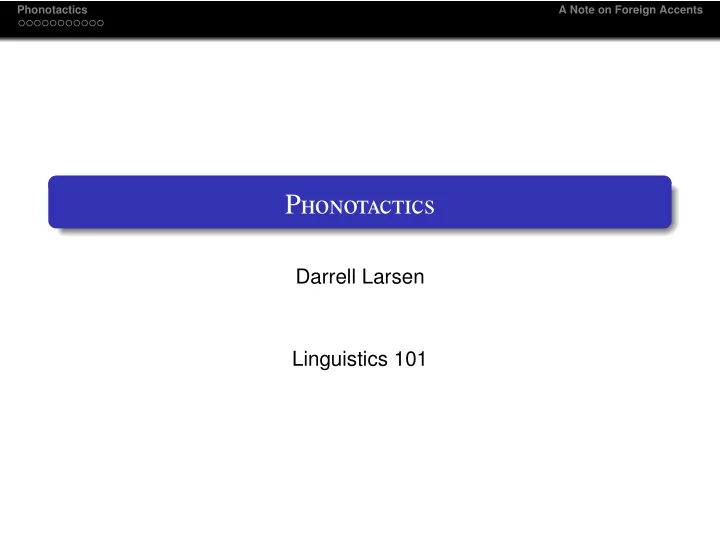

Phonotactics A Note on Foreign Accents P honotactics Darrell Larsen Linguistics 101
Phonotactics A Note on Foreign Accents O utline 1 P honotactics Syllable Structure Constraints Sound Sequence Constraints Resolving Constraint Violations 2 A N ote on F oreign A ccents
Phonotactics A Note on Foreign Accents P honotactics O verview Phonotactics is part of the phonology of a language. Phonotactics restricts the possible sound sequences and syllable structures in a language. Phonotactic constraint refers to any specific restriction.
Phonotactics A Note on Foreign Accents S yllable S tructure Syllables consist of vowels and consonants. Syllables can be split into an onset, nucleus and coda. All syllables have a nucleus.
Phonotactics A Note on Foreign Accents S yllable S tructure S yllable S tructure syllable onset rime nucleus coda S yllable S tructure E xamples syllable syllable syllable rime C rime CCC rime V V C V CCC
Phonotactics A Note on Foreign Accents S yllable T ypes Languages differ in permissible syllable structures. Below are some simplified examples. H awaiian J apanese K orean V, CV V, CV, CVC V, CV, CVC, VCC, CVCC E nglish V CV CCV CCCV VC CVC CCVC CCCVC VCC CVCC CCVCC CCCVCC VCCC CVCCC CCVCCC CCCVCCC
Phonotactics A Note on Foreign Accents S yllable T ypes There are further constraints on which specific types of consonants or vowels may appear in specific positions. In Japanese CVC syllables, only nasals may appear in coda position. There may be dialectal variation. Only some Korean speakers allow CC sequences. Dialect A: [ilk.ta] ‘to read’ Dialect B: [ik.ta] ‘to read’
Phonotactics A Note on Foreign Accents E nglish C onsonant S equences English disallows [ Z ] and [ N ] in onset position. *[ NOt ] (cf. Vietnamese [ NaĂ£ ] ‘Russia’) English disallows [h] in coda position. *[ loh ] (cf. many varieties of Spanish [ loh ] los ‘the’)
Phonotactics A Note on Foreign Accents S ound S equence C onstraints Languages also have constraints on specific sound sequences. Such constraints often refer to features rather than specific sounds.
Phonotactics A Note on Foreign Accents E nglish C onsonant S equences C onsonant C lusters English allows CC and CCC clusters in onsets and codas, but they are highly restricted. E nglish O nset C lusters ( simplified ) CC stop, fricative + liquid, glide [s] + voiceless stop, nasal CCC [s] + voiceless stop + liquid, glide
Phonotactics A Note on Foreign Accents E nglish C onsonant S equences C onsonant C lusters In codas, nasals may precede voiceless plosives, but only if they share the same place of articulation. jump [ dZ2mp ], stunt [ st2nt ], stink [ stINk ] *jumk [ dZ2mk ], *stunp [ st2np ], *stingt [ stINt ]
Phonotactics A Note on Foreign Accents R esolving C onstraint V iolations Prohibited sounds sequences may arise for various reasons, including: borrowing from another language tsunami [ sunami ] or [ tsunami ], from Japanese [ tsWnami ] putting affixes, words together sequentially cost + s → *sts next store → *stst
Phonotactics A Note on Foreign Accents R esolving C onstraint V iolations Languages have many ways of resolving constraint violations. delete a sound e.g. English, Dialect A: *sts ghosts / goUst / → [ goUss ] next store / nEkststoUô / → [ nEksstoUô ] insert a sound e.g. Korean *CC (generally): English ‘Sprite’ [ spôaIt ] → Korean [ s1.p h 1.Ra.i.t h 1 ] assimilate a sound e.g. English disallows adjacent stops if they differ in voicing walk / wAk / + -ed / d / → [ wAkt ] etc.
Phonotactics A Note on Foreign Accents R esolving C onstraint V iolations Identical constraints may be resolved it in different ways. Consider the constraint * sts from some dialects of English. Dialect A: resolve via deletion ghosts / goUst / → [ goUss ] Dialect B: resolve via insertion ghosts / goUst / → [ goUst@z ] or [ goUst@s@z ] Constraints have different scopes in different dialects. e.g. a constraint may apply within a word only, across word boundaries, or both.
Phonotactics A Note on Foreign Accents A N ote on F oreign A ccents Why are there foreign accents? Different phonotactic constraints e.g. Spanish vs. English: [s]+stop syllable-initially Different phonological rules e.g. English aspirates word-initial stops, Spanish and French don’t.
Phonotactics A Note on Foreign Accents A N ote on F oreign A ccents Why are there foreign accents? Different sound inventories e.g. French has [ K ], English does not. Inability to perceive sound distinctions e.g. Korean ‘uncooked rice’ [ sal ] vs. ‘flesh’ [ s’al ] Inability to produce sounds
Recommend
More recommend